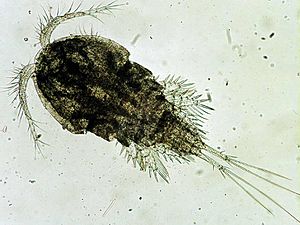Maxillopoda facts for kids
Quick facts for kids MaxillopodaTemporal range: Cambrian to Recent
|
|
|---|---|
 |
|
| Cyclops (Copepoda: Cyclopoida) | |
| Scientific classification | |
| Kingdom: | |
| (unranked): | |
| Phylum: | |
| Subphylum: | |
| Class: |
Maxillopoda
Dahl, 1956
|
| Sub-classes | |
|
|
Maxillopoda is a diverse class of crustaceans which includes the barnacles, copepods and a number of related animals.
It does not appear to be a monophyletic group, and no single character unites all the members.
Contents
Description
With the exception of some barnacles, maxillopodans are mostly small, including the smallest known arthropod, Stygotantulus stocki. They often have short bodies, with the abdomen reduced in size, and generally lacking any appendages This may have arisen through paedomorphosis.
Apart from barnacles, which use their legs for filter feeding, most maxillopodans feed with their maxillae. Their bodyplan has 5 head segments, 6 thoracic segments and 4 abdominal segments, followed by a telson (tailpiece).
Fossil record
The fossil record of the group extends back into the Cambrian, with fossils of barnacles and tongue worms known from that period.
Classification
Six subclasses are generally recognised, although many works have included the ostracods among the Maxillopoda. Of the six groups, only Mystacocarida are entirely free-living; all the members of the Tantulocarida, Pentastomida and Branchiura are parasitic, and many of the Copepoda and Thecostraca are parasites.
See also
 In Spanish: Crustacea para niños
In Spanish: Crustacea para niños

